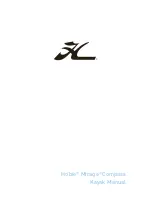
Owner’s Manual Page 39
Basic Seamanship - Section C
Figure C2: Crossing Situation
4. Overtaking
The boat overtaking the one ahead must yield the
right-of-way to the boat being passed. The overtaking
boat must make necessary adjustments to keep out of
its path. The boat being passed should hold its course
and speed. See Figure C-3.
Inland Rules
“I want to pass you on your
port side.
2 short blasts (1 sec.)
“Proceed”
2 short blasts (1 sec.)
International Rules
“I am altering my course
to port.”
2 short blasts (1 sec.)
International Rules in Nar-
row Channels
“I intend to pass you on
your port side.”
2 prolonged blasts (4-6
sec.)
2 short blasts (1 sec.)
“Proceed.”
1 prolonged, 1 short
1 prolonged, 1 short
Stand-on (Privileged)
Vessel Being Overtaken
Give-way (Burdened)
Vessel Overtaking
Inland Rules
“I want to pass you on your
starboard side.
1 short blast (1 sec.)
“Proceed”
1 short blast (1 sec.)
International Rules
“I am altering my course to
starboard.”
1 short blast (1 sec.)
International Rules
in Narrow Channels
“I intend to pass you on
your
starboard side.”
2 prolonged blasts (4-6
sec.)
1 short blast (1 sec.)
“Proceed.”
1 prolonged, 1 short
1 prolonged, 1 short blast
Figure C3: Overtaking
5. The General Prudential Rule
The general prudential rule regarding right-of-way is
that if a collision appears unavoidable, neither boat has
right-of-way. As prescribed in the “Rules of the Road”,
both boats must act to avoid collision.
6. Night Running
Boats operating between sunset and sunrise (hours
vary by state), or in conditions of reduced visibility,
must use navigational lights. Nighttime operation,
especially during bad weather or fog, can be danger-
ous. All “Rules of the Road” apply at night, but it is
best to slow down and stay clear of all boats regard-
less of who has right-of-way.
To see more easily at night, avoid bright lights when
possible. Also, it is helpful to have a passenger keep
watch for other boats, water hazards, and naviga-
tional aids.
To determine the size, speed and direction of other
vessels at night, you should use running lights.
A green light indicates the starboard side, and the
red light indicates the port side. Generally, if you see
a green light, you have the right-of-way; if you see
a red light, give way to the other vessel. See Figure
C4.
Figure C4: Night Running
7. Whistle Signal
Out on the water, whistle signals are commonly used.
Although using a whistle signal is not necessary
every time a boat is nearby, operators must signal
their intentions when necessary to avoid potentially
confusing or hazardous situations. Use whistle blasts
early enough to be noticed and understood by other
boaters.
It is customary for the privileged boat to signal first
and the yielding boat to return the same signal to
acknowledge she understands and will comply.
Use the danger signal (five or more short and rapid
Danger Zone
112.5
o
Summary of Contents for S Series
Page 1: ......
Page 2: ......
Page 49: ...Owner s Manual Page 47 Warranty and Service Section D ...
Page 51: ...Owner s Manual Page 49 Warranty and Service Section D ...
Page 52: ...Owner s Manual Page 50 Warranty and Service Section D ...
Page 53: ...Owner s Manual Page 51 Warranty and Service Section D ...
Page 179: ......
Page 180: ...www fourwinns com ...
















































